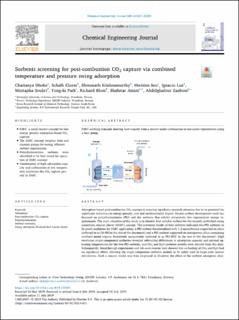| dc.contributor.author | Dhoke, Chaitanya | |
| dc.contributor.author | Cloete, Schalk Willem Petrus | |
| dc.contributor.author | Krishnamurthy, Shreenath | |
| dc.contributor.author | Seo, Hwimin | |
| dc.contributor.author | Luz, Ignacio | |
| dc.contributor.author | Soukri, Mustapha | |
| dc.contributor.author | Park, Yong-ki | |
| dc.contributor.author | Blom, Richard | |
| dc.contributor.author | Amini, Shahriar | |
| dc.contributor.author | Zaabout, Abdelghafour | |
| dc.date.accessioned | 2020-10-27T11:54:50Z | |
| dc.date.available | 2020-10-27T11:54:50Z | |
| dc.date.created | 2020-07-08T14:34:46Z | |
| dc.date.issued | 2020 | |
| dc.identifier.citation | Chemical Engineering Journal. 2020, 380 . | en_US |
| dc.identifier.issn | 1385-8947 | |
| dc.identifier.uri | https://hdl.handle.net/11250/2685238 | |
| dc.description.abstract | Adsorption-based post-combustion CO2 capture is enjoying significant research attention due to its potential for significant reductions in energy penalty, cost and environmental impact. Recent sorbent development work has focussed on polyethyleneimine (PEI) and dry sorbents that exhibit attractively low regeneration energy requirements. The main objective of this study is to identify best suitable sorbent for the recently published swing adsorption reactor cluster (SARC) concept. The screening results of four sorbents indicated two PEI sorbents to be good candidates for SARC application: a PEI sorbent functionalized with 1,2-epoxybutane supported on silica (referred to as EB-PEI in the rest of the document) and a PEI sorbent supported on mesoporous silica containing confined metal organic framework nanocrystals (referred to as PEI-MOF in the rest of the document). High resolution single-component isotherms revealed substantial differences in adsorption capacity and optimal operating temperatures for the two PEI sorbents, and CO2 and H2O isotherm models were derived from this data. Subsequently, breakthrough experiments and lab-scale reactor tests showed that co-feeding of CO2 and H2O had no significant effect, allowing the single-component isotherm models to be safely used in large-scale reactor simulations. Such a reactor model was then employed to illustrate the effect of the sorbent adsorption characteristics on the efficiency of the novel swing adsorption reactor cluster, which combines pressure and temperature swings. The EB-PEI and PEI-MOF sorbents were compared to a previously published PEI sorbent with distinctly different adsorption behaviour and recommendations for future sorbent development work were made. | en_US |
| dc.language.iso | eng | en_US |
| dc.publisher | Elsevier | en_US |
| dc.rights | Attribution-NonCommercial-NoDerivatives 4.0 Internasjonal | * |
| dc.rights.uri | http://creativecommons.org/licenses/by-nc-nd/4.0/deed.no | * |
| dc.subject | Swing adsorption fluidized bed reactor cluster | en_US |
| dc.subject | Sorbent screening | en_US |
| dc.subject | Polyethyleneimine | en_US |
| dc.subject | CO2 capture | en_US |
| dc.subject | Post-combustion | en_US |
| dc.subject | Adsorption | en_US |
| dc.title | Sorbents screening for post-combustion CO2 capture via combined temperature and pressure swing adsorption | en_US |
| dc.type | Peer reviewed | en_US |
| dc.type | Journal article | en_US |
| dc.description.version | publishedVersion | en_US |
| dc.rights.holder | This article is available under the Creative Commons CC-BY-NC-ND license and permits non-commercial use of the work as published, without adaptation or alteration provided the work is fully attributed. | en_US |
| dc.source.pagenumber | 12 | en_US |
| dc.source.volume | 380 | en_US |
| dc.source.journal | Chemical Engineering Journal | en_US |
| dc.identifier.doi | 10.1016/j.cej.2019.122201 | |
| dc.identifier.cristin | 1818954 | |
| dc.relation.project | Norges forskningsråd: 268507 | en_US |
| cristin.ispublished | true | |
| cristin.fulltext | original | |
| cristin.qualitycode | 2 | |

